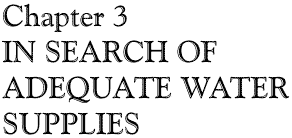
| ch. 3, pp. 33 |
Collected and stored rainwater can be used for evaporative cooling, toilet flushing, car washing, chlorinated swimming pools, and surface irrigation, especially in food gardens. In the United States harvested rainfall mostly is used for irrigation, with limited other domestic uses. At Casa del Agua, where the landscape was almost entirely irrigated by graywater, rainwater primarily was used in the evaporative cooler, with a limited amount used for toilet flushing. Casa del Agua’s rainwater storage capacity was about 8,000 gallons. Rainwater harvesting systems vary from the simple and inexpensive to the complex and very costly. Directing rainfall to plants located at contoured low points is a very simple rainwater harvesting system. No rain escapes property boundaries. More complex rainwater harvesting systems include water storage. Rainwater harvesting is an everyman’s water augmentation method. Any container capable of holding rain dripping from roof or patio can be a rainwater harvesting system, but may also breed mosquitoes unless kept covered. A plastic garbage barrel is sufficient. Sturdier and more elegant containers create a more pleasing effect and some are built using backyard technology, such as small ferro cement tanks collecting water at the base of down spouts. The least expensive rainwater storage system uses an above-ground swimming pool, with a lid or cover to reduce evaporation. Rainwater then can be stored for about .07 cents per gallon. Harvested rain raises some water quality concerns. Rain in certain urban areas may contain various impurities absorbed from the atmosphere, including arsenic and lead. Certain desert conditions also can cause rainwater quality concerns. Desert rain is infrequent and, therefore, bird droppings, dust and other impurities accumulate between rain events. They then occur in high concentrations in runoff when it does rain. As a result, the quality of harvested rainfall needs frequent monitoring especially if used for potable uses. To confront these problems some systems reject the initial rooftop runoff.
|
